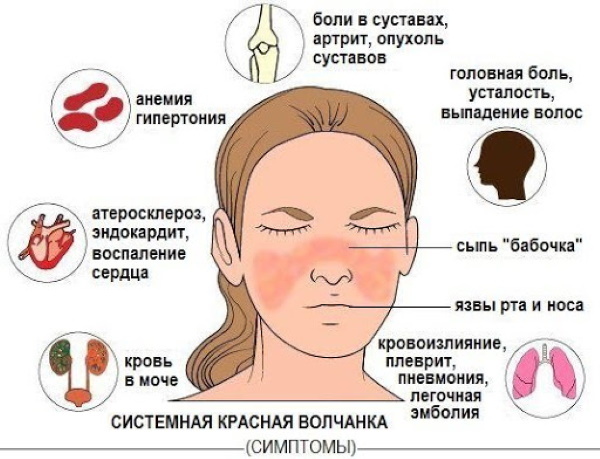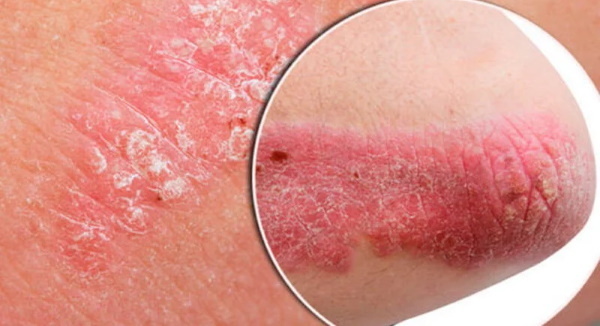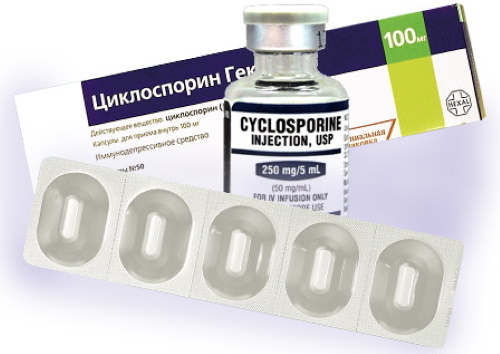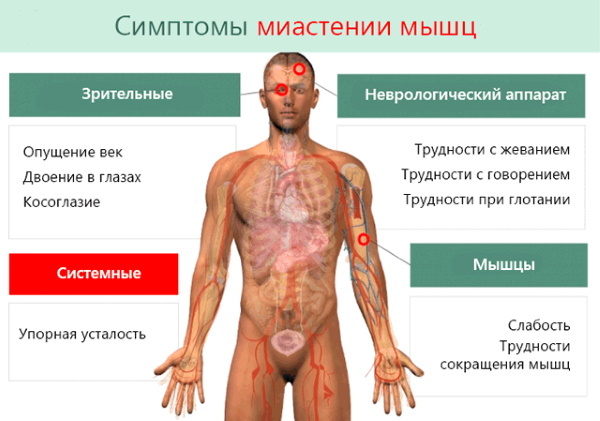Autoimmune diseases are pathologies in which the tissues of the immune system are destroyed. Most often women suffer diseases than men. In total, there are about 140 diseases in this category, the list of diseases (the most common) can be viewed in the article.
Record content:
- 1 Classification
-
2 Systemic lupus erythematosus
- 2.1 Views
- 2.2 Symptoms and Signs
- 2.3 Causes
- 2.4 Treatment methods
- 2.5 Possible consequences and complications
-
3 Psoriasis
- 3.1 Views
- 3.2 Stages and degrees
- 3.3 Symptoms and Signs
- 3.4 Causes
- 3.5 Treatment methods
- 3.6 Possible consequences and complications
-
4 Myasthenia gravis
- 4.1 Views
- 4.2 Stages and degrees
- 4.3 Symptoms and Signs
- 4.4 Causes
- 4.5 Treatment methods
- 4.6 Possible consequences and complications
- 5 Autoimmune Disease Videos
Classification
Autoimmune diseases (the list of diseases is presented below) can be divided into several groups.

The most general classification of pathologies:
| View | Description | Examples of |
| Organ-specific | With this type of disease, a separate tissue and organ are affected. | Crohn's disease, type 1 diabetes mellitus, primary myxedema, Addison's disease, male infertility, pemphigus vulgaris. |
| Systemic | Systemic autoimmune diseases are characterized by damage to multiple organs or systems. | Systemic lupus erythematosus, Sjogren's syndrome, rheumatoid arthritis, systemic scleroderma, polymyositis. |
Crohn's disease is an inflammatory disease of the gastrointestinal tract that affects all parts of the body. It is expressed by abdominal pain, as well as the appearance of blood and mucus in the stool. For treatment, corticosteroids (Salofalk) are used, and a lifestyle change is also required.
Addison's disease affects the adrenal glands, due to which they lose their ability to reproduce the hormone. It is expressed by the disease by burning the tongue, dry mucous membranes. Treatment consists of hormone therapy, which replaces the lost hormone (use "Hydrocortisone", "Fludrocortisone").
Myxedema is a disease characterized by a non-flow of thyroid hormone into the bloodstream. The development of the disease is accompanied by swelling, weakness and pain in the heart. As a treatment, hormone therapy is prescribed ("Thyroxin" "Thyroidin").
Scleroderma is manifested by impaired blood supply and hardening of tissues and organs. Scleroderma affects many systems and organs of a person, and its characteristic manifestation is Raynaud's syndrome. Treatment is prescribed individually.
Polymyositis is an inflammation of muscle tissue. It manifests itself as weakness and pain in the limbs. The mainstay of treatment is glucocorticoids ("Prednisol"), but also drugs that block muscle pain.

Arthritis is an inflammatory disease of the joints. One of the most striking and specific symptoms is morning stiffness. During treatment it is necessary to eliminate pain and prevent an inflammatory reaction ("Baclofen", "Piaskledin").
| Subspecies | Examples of |
| Hormone dependent | Autoimmune pancreatitis and hepatitis, Basedow's disease, type 1 diabetes mellitus, autoimmune thyroiditis. |
| Arthritis | Rheumatoid arthritis, Reiter's syndrome, Bakhterev's disease, acute rheumatic fever, psoriatic arthritis. |
| Affecting the central nervous system | Myasthenia gravis, multiple sclerosis, chronic polyneuropathies, autoimmune encephalitis, Guillain-Barré syndrome. |
| Skin lesions | Psoriasis, Vitiligo, alopecia areata, scleroderma, dermatomyositis. |
| Influencing the work of the gastrointestinal tract | Celiac disease, autoimmune hepatitis, primary biliary cirrhosis, Crohn's disease, ulcerative colitis. |
| Disturbances in the visual apparatus | Sjogren's syndrome, acute anterior uveitis, exogenous uveitis. |
| Influencing the cardiovascular system | Hemolytic anemia, polyarteritis nodosa, antiphospholipid antibody syndrome, platelet destruction. |
Systemic lupus erythematosus
Systemic lupus erythematosus is a chronic inflammatory autoimmune disease.

The peculiarity of this disease lies in its periodicity: relative remission and exacerbation of the disease, during which any organ damage is possible.
Views
There are several types of systemic lupus erythematosus:
| Acute current | Subacute course | Primary chronic course |
| The disease develops in 3-6 months, and as a result, it affects the vital organs. | It is characterized by undulating manifestations. Develops within 2-3 years | For a long time, 1-2 manifestations appear, more dangerous diseases (affecting important organs) appear in the 5-10th year of the development of the disease. |
A variety is also distinguished according to the degree of activity. This system uses points that characterize the disease depending on the severity of clinical symptoms. The highest manifestation of lupus is very high activity (20 points or more), the lowest is lack of activity (0 points).
Symptoms and Signs
Symptoms of SLE:
- common manifestations include weakness, fever, weight loss (abrupt), hair loss;
- in 90% of cases, skin problems develop - they can be both minimal and severe;
- joint problems are also one of the most common problems with lupus. Arthritis pain, mostly migratory;
- with lupus, kidney problems (nephritis) occur. This manifestation is most typical for SLE, occurs more often than others;
- lung problems. Shortness of breath, cough, and pain can result from pleurisy;
- with SLE, inflammation of the coronary arteries, heart muscles, and heart valves is possible.

Also, with lupus, there is a possibility of epileptic seizures.
Causes
The etymology of systemic lupus is not fully understood.
There are the following factors that presumably affect the onset of the disease:
- environment. This includes not only UV radiation, but also the effects of medicinal, toxic substances. The influence of viruses and microorganisms on the body is also possible;
- hormonal tension;
- genetics. The frequency of manifestations of systemic lupus erythematosus in identical twins is 5 or more times higher than in fraternal twins.
It is believed that the development of SLE is influenced by salts of heavy metals, mercury, oral contraceptives.
Treatment methods
When treating SLE, it is necessary, first of all, to reduce the activity of the disease, as well as to eliminate the likelihood of the appearance of third-party diseases. It is important to induce remission of SLE as soon as possible so that the patient maintains vital functions at the same level. Lupus treatment is medication.
The following groups of drugs are used:
- Glycocorticoids. They affect the adrenal glands, preventing inflammation in this area. The most effective are Urbazon, Medrol.
-
Cytostatics. Drugs in this group regulate the activity of the production of immune cells. Most often they use "Cyclophosphamide", "Azathioprine", "Methotrexate".

- Non-steroidal anti-inflammatory prescribed for muscle pain. Basically, various gels and ointments (Naiz) or powders (Nimesil) are prescribed.
In addition to drug treatment, treatment is practiced using physicochemical techniques. Plasmapheresis is a procedure in which the patient's blood is cleansed of immune cells and then returned to the bloodstream.
In addition to constant drug treatment, the patient is subject to dispensary observation. A patient with SLE needs to be tested once every 3 months, annually undergo an examination for the development of third-party diseases and the timely prevention of their development.
Possible consequences and complications
Due to timely treatment, as well as the use of new technologies, the survival rate has increased to 95% over the past 5 years.
Possible complications in case of unfavorable development of the disease:
- complication of drug therapy;
- kidney damage;
- high blood pressure;
- high activity of SLE;
- infectious diseases.
These complications can provoke death and the appearance of the most serious third-party diseases of vital organs.
Psoriasis
Autoimmune diseases (a list of diseases can be viewed in the article) are pathologies that are associated with improper production or multiplication of antibodies and autoaggressive cells.

One of these diseases is psoriasis.
Views
There are 2 main groups of the disease:
- Pustular psoriasis. It includes annular psoriasis, palmoplantar, generalized, palmar-plantar and herpetiform psoriatic impetigo.
- Non-pustular. This type includes ordinary psoriasis and psoriatic erythroderma.
In addition to this classification, you can find a distribution by degrees of severity.
Stages and degrees
Forms of psoriasis by severity:
- easy. The defeat is no more than 3% of the skin;
- moderate. The lesion is 3-10% of the skin;
- severe psoriasis Is a disease in which more than 10% of the skin is affected or joints are affected.
In most cases, psoriatic plaques appear on the skin, which are covered with a white coating.
There are the following stages in the development of psoriasis:
- Progressive. In the process, new plaques appear and are actively developing.
- Stationary. The appearance of new plaques stops, the top layer of the skin, which has been affected by the disease, forms characteristic folds.
- Regressive. Peeling stops, plaques disappear. Pigmentation appears at the sites of the rashes.
Symptoms depend on the stage of the disease.
Symptoms and Signs
Psoriasis is not only skin and nail damage. Most often, this disease is called psoriatic disease, since in addition to the standard symptoms, a large person feels constant weakness and depression against the background of a deteriorated general well-being.

Autoimmune diseases (the list of diseases can be viewed above), which includes psoriasis, affect many areas of the body. In this regard, various symptoms are distinguished, depending on the focus of inflammation.
| Disease type | Scalp psoriasis | Psoriasis of nails | Psoriasis of feet and palms |
| Symptoms | Psoriatic plaques are covered with scales that look like dandruff. In the process of plaque development, the hair is not affected. | Pits or inflammation similar to a fungus appear. The plate gets thicker and changes color. | A pronounced symptom of psoriasis is thickening of the layers of the skin. Rough skin appears on the feet and palms, as cells multiply 8 times faster, but are not removed over time. |
In most cases, UV rays have a positive effect on the body. Among the common symptoms of psoriasis are: depression, weakness and chronic fatigue, the appearance of scales.
Causes
The exact causes of psoriasis are not fully understood.
Scientists identify 2 theories of the onset of the disease:
- immune cells penetrate into the upper layers of the skin and trigger a reaction that provokes increased division of skin cells;
- with psoriasis, the growth, division and maturation of the epithelium are disturbed.
Among the factors that contribute to the development of psoriasis are HIV, medication, stress, trauma and infection.
Treatment methods
Treatment is selected individually for each patient. The most effective method is selected depending on the symptomatology, stage and type of the disease.
Among the medicines, the most effective are recognized:
- Tigason, Neotigason (retinoids). Influence the maturation of skin layers;
-
Cyclosporin A (immunosuppressant). Reduces the activity of skin cell division;

- "Methotrexate" (cytostatic). Affects the growth rate of atypical epidermal cells.
Physiotherapy methods are used not only to create a complex treatment, but also in cases where drug treatment is impossible.
The following methods are practiced:
- electrosleep. Exposure to the brain with electrical impulses (weak) has a mild sedative effect, as a result of which the plaques dissolve;
- laser therapy promotes resorption of plaques and protects against scarring;
- selective phototherapy used to irradiate the skin with UV rays;
- hyperthermia - this is the heating of the skin with special pads to a temperature of 40 ° C. Due to this, the work of the immune system is normalized;
- bee venom treatment it turns out to be anti-inflammatory, antipruritic and absorbable effect.
With psoriasis, it is important for the patient to follow a diet.
The following food categories should be absent from the diet:
- alcoholic drinks;
- animal fats;
- red fish;
- smoked products;
- fat meat;
- eggs;
- coffee;
- drinks with gas;
- sweet and flour.
2 times in 7 days, it is recommended to carry out fasting days based on kefir, apples or vegetables.
Possible consequences and complications
With untimely or ineffective treatment, as well as if the disease spreads very quickly, complications may occur.
Psoriasis negatively affects the following organs and systems of the body:
- gastrointestinal tract;
- eyes;
- kidneys and liver;
- the cardiovascular system;
- endocrine system;
- excretory system.
Psoriasis is not a fatal disease. Complications that cause psoriasis can be fatal, or increase the likelihood of death tenfold.
Myasthenia gravis
Autoimmune diseases (a list of diseases can be viewed in the article) can be progressive.

These include myasthenia gravis, also called myasthenia gravis or Erb-Goldflam disease.
Views
Myasthenia gravis is divided into several forms. These include generalized and local.
Local form of myasthenia gravis:
- Bulbar. For this form, the characteristic features are slurred speech, liquid entering the nose and choking on solid food;
- Ophthalmic the form is characterized by strabismus, double vision, drooping of the upper eyelids. This form is not life-threatening;
- Cranial the form is accompanied by a violation of the work of the masticatory muscles, slurred speech and sluggish facial expressions.
If untreated, the ocular form may develop into generalized myasthenia gravis.
Generalized forms of the disease:
- neonatal myasthenia gravis appears in newborns (in some cases) born to a mother with this disease. The ailment is temporary, the symptoms disappear a few weeks after birth;
- congenital myasthenia gravis is a rare form of the disease. Appears in children from birth, and symptoms remain for life. Allocate a benign appearance and family myasthenia gravis;
- juvenile myasthenia gravis appears after 10 years;
- generalized myasthenia gravis in adults.
For generalized myasthenia gravis, division into stages is also characteristic. Autoimmune disease can be divided according to the nature of the course.
There are 4 main forms:
- myasthenic episodes. They are characterized by rapid regression of the disease. And the intervals between episodes can last up to 10 years;
- myasthenic condition - this is the appearance of symptoms and their development within 2-3 months with further stabilization;
- progressive myasthenia gravis develops very slowly. Quickly leads to a stable state of a person;
- malignant myasthenia gravis - the most severe form of the disease, which leads to an aggravation of the condition due to the involvement of new muscles in the pathological processes.
Any form of the disease requires urgent treatment.
Stages and degrees
Generalized myasthenia gravis in adults is divided into stages:
- easy;
- moderate;
- heavy;
- sharp;
- late severe;
- with early development of muscle atrophy.
Myasthenia gravis in adults can be easily confused with illness associated with work fatigue or stress. The symptoms are quite similar: tiredness, fatigue, weakness.
Symptoms and Signs
Autoimmune disease (myasthenia gravis) is manifested by ophthalmic diseases, fatigue of the chewing and facial muscles.

A complete list of symptoms, depending on the form and type:
- for generalized myasthenia gravis, swallowing disorders, breathing disorders and weakness of the muscles of the body are characteristic;
- the most striking symptom of benign myasthenia gravis is complete immobility of the eyeballs;
- family childhood myasthenia gravis is characterized by choking while eating, difficulty swallowing, weakness of the respiratory muscles;
- the youthful form of the disease manifests itself through immobilization of the eyeballs, drooping eyelids, impaired swallowing;
- bulbar myasthenia gravis is characterized by a nasal voice, slurred speech;
- for ocular myasthenia gravis, only the muscles of the eyes and eyelids are affected;
- cranial myasthenia gravis is manifested through damage to the cranial nerves, speech impairment and pathologies of the masticatory and facial muscles.
In addition to these symptoms, limb weakness, coughing and hoarseness may occur.
Causes
The body produces antibodies to receptor proteins. Antibodies destroy receptors that make contact between nerve and muscle.
Among the causes of myasthenia gravis are the following:
- gene mutation;
- tumors of the thymus;
- scleroderma;
- dermatomyositis.
The most rare causes of the onset of the disease are tumors of the genitals, lungs and liver.
Treatment methods
When treating myasthenia gravis, refer to the following methods:

| Operative treatment | Conservative | |||
| Thymectomy | Drug treatment | Radiotherapy | Enterosorption | Plasmapheresis |
| Thymus gland removal procedure. | For the treatment of the disease, anticholine-esterase drugs are used, which contribute to the growth of muscle strength, anabolic steroids. | A procedure based on the treatment of ionizing radiation. | The procedure for introducing a non-invasive procedure of sorbents into the body to remove exogenous substances, micro-organisms and toxins from the gastrointestinal tract. | The procedure for collecting and purifying blood with the return of a part to the bloodstream. |
Complementary therapies are also used to eliminate or relieve symptoms of the disease.
Possible consequences and complications
With myasthenia gravis, the neurotransmitter acetylcholine malfunctions. The deficiency leads to pathologies in the respiratory center. The most significant complications are cholinergic and myasthenic crises.
Autoimmune diseases are a group of diseases in which the immune system is impaired. The body perceives "native" cells as foreign. AIZ is recognized as one of the most difficult and difficult to treat. A complete list of pathologies with classification and description can be viewed in the article.
Autoimmune Disease Videos
One of the autoimmune diseases is lupus erythematosus:



